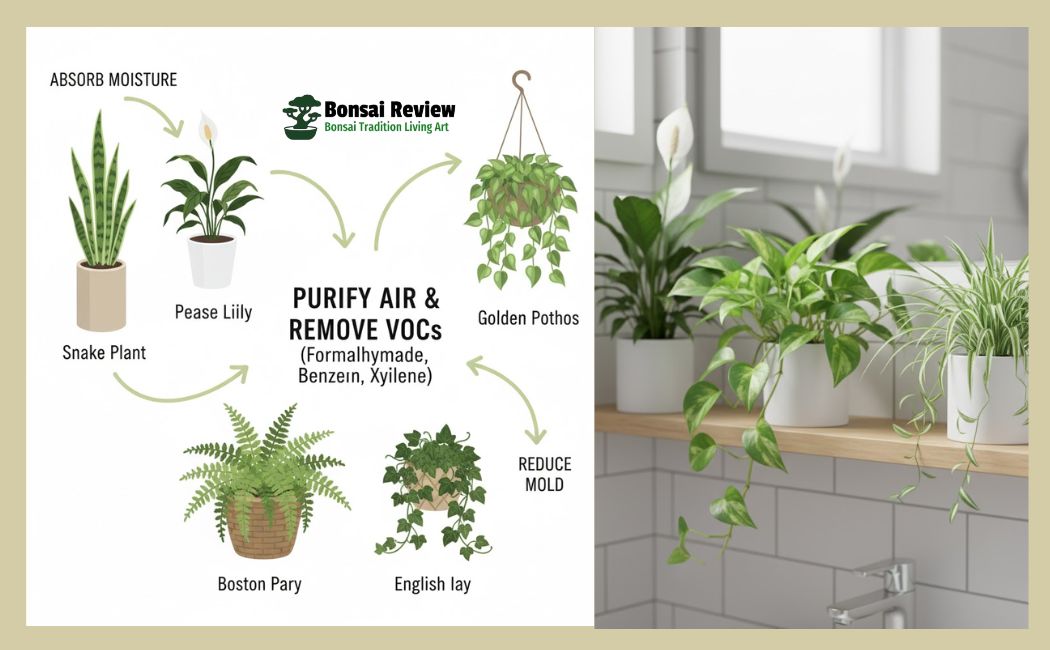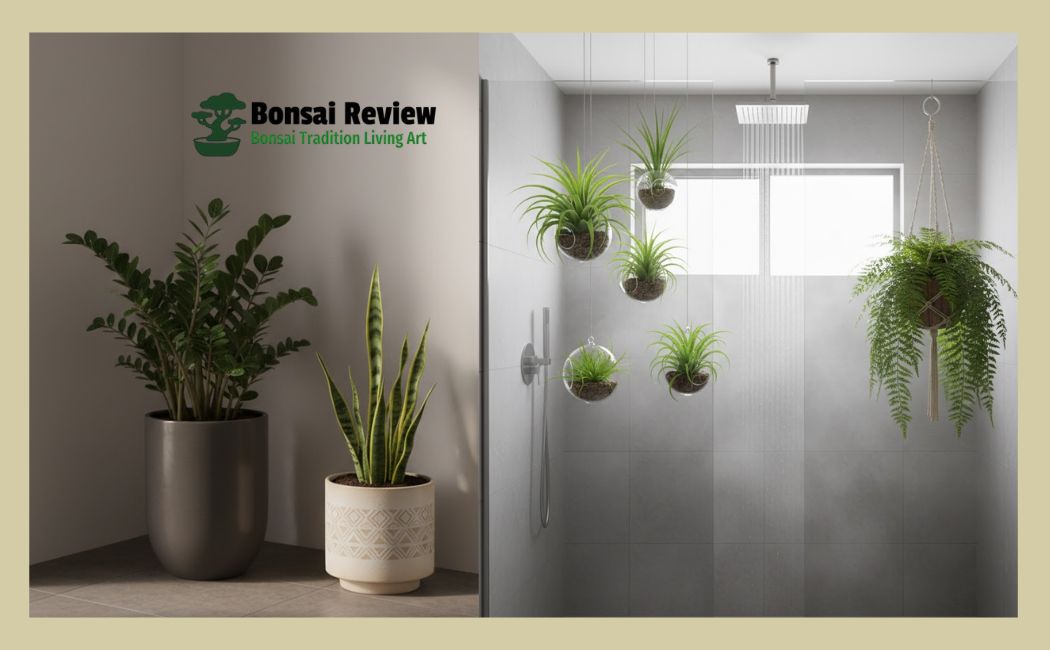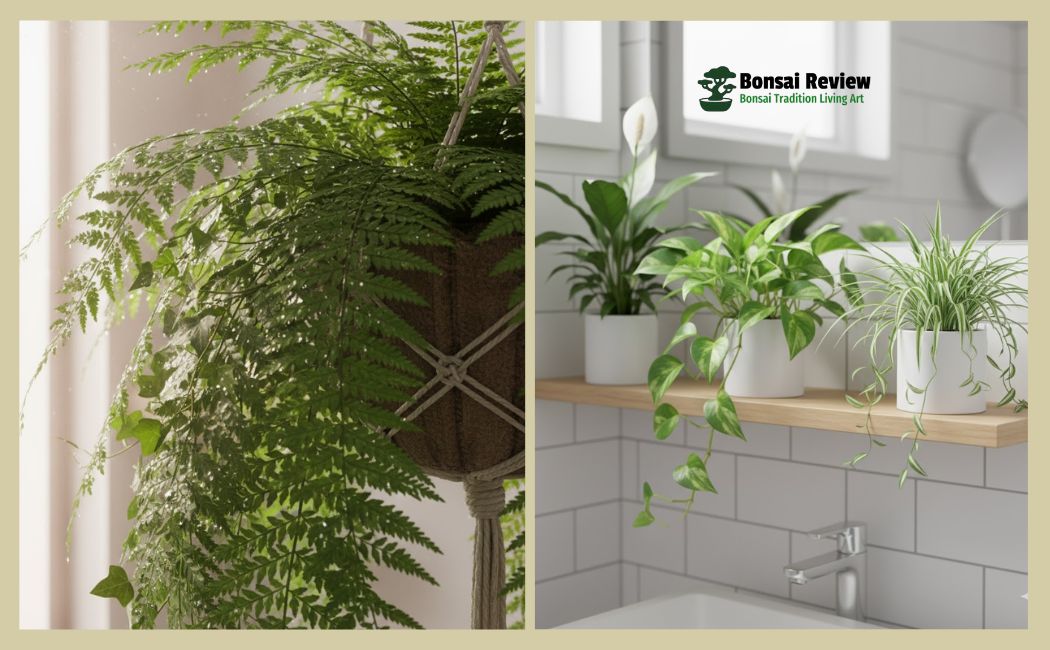Best plants for bathroom air quality are helpful when your bathroom feels damp, heavy, or has a little musty smell after each shower.
In a washroom, there is often high humidity, low light, and sometimes no light at all, which can lead to mold, damp air, and poor ventilation.
You may feel the air is not fresh, and the space does not feel clean, even when you try to keep the closet tidy.
Some air-purifying indoor plants can help here. These plants can absorb moisture, reduce airborne mold spores, and help remove VOCs such as formaldehyde and benzene from soaps and cleaners.
For example, Snake Plant (Sansevieria trifasciata) can live in low light and release oxygen at night.
Golden Pothos (Epipremnum aureum) can grow even in a no-light bathroom corner and works like a natural air filter.
Boston Fern (Nephrolepis exaltata) loves steam and helps reduce humidity. And English Ivy (Hedera helix) is known to help with mold in damp rooms.
By choosing the right indoor plants for bathroom spaces, you can make the air feel lighter, cleaner, and more comfortable without much care or effort.
Why Washroom Air Gets Heavy?
Your bathroom holds more moisture than any other room. Each time you take a warm shower, the air fills with steam, and this steam stays in the room when there is poor ventilation or no window to let the air move out.
This creates high humidity and damp air, which can allow mold to grow on walls, tiles, and even inside corners. You may also notice a musty smell that does not go away.
On top of that, daily products like shampoo, soap, body wash, and cleaners can release tiny VOCs such as formaldehyde and benzene into the air.
These are very small chemicals that you cannot see, but they affect how fresh your bathroom feels. This is why some rooms feel stuffy, even when they look clean.
The good news is, some air-purifying indoor plants naturally help absorb moisture, reduce these VOCs, and make the air feel lighter again. This means you do not need heavy tools or dehumidifiers, and the right plants can do the work for you.
What Kind of Plants Fit Best in a Washroom?
Not every houseplant can live in a bathroom, because the air is wet, the light may be low, and the room can stay warm and steamy for long periods. You need plants that feel comfortable in this kind of space.
Look for plants that enjoy high humidity, can survive in low light or no light corners, and can help absorb moisture from the air.
If your bathroom has a window, you can choose plants that like indirect light or filtered light on the windowsill. If your bathroom has no window, choose plants like Snake Plant or ZZ Plant that can handle very low light and still stay healthy.
It also helps to pick plants with broad leaves, because they can take in more steam and work better as natural air filters. And if your closet is small, you can use hanging plants or place them on a high shelf so they stay safe from water splashes.
When you choose plants that match your bathroom’s light and humidity levels, you get a plant that grows well and keeps your air clean, fresh, and easy to breathe.

9Best Plants for Bathroom Air Quality: NASA-Approved Air-Purifying Plants for Your Closet is Simple and Effective.
You may feel your closet air is heavy or damp. You want a fresh smell and clean air, but you also want plants that do not die. Some dwarf plants can live well in warm steam, low-light, and wet conditions. They can even remove bad smells.
Let me show you which plants will fit best in your bathroom, and how you can care for them with ease.
Here are the best nine tiny plants that work well with low light, high humidity, and help clean the air, so your washroom feels fresh and calm.
1. Snake Plant (Sansevieria trifasciata): Best Plants for Bathroom Air Quality Low-light.
Snake Plant (Sansevieria trifasciata) is a unique dwarf plant that is very strong and easy to care for, and can live in low light or even a no-light washroom corner. It helps filter VOCs like formaldehyde from soaps and cleaners. It also releases oxygen at night, which helps the air feel light and clean.
2. Golden Pothos (Epipremnum aureum): Best Plants for Bathroom Air Quality Hanging Tob Plants.
This plant grows fast and enjoys humidity. Golden Pothos (Epipremnum aureum) works like a natural air filter and removes benzene and other toxins from the air. You can keep it as a hanging plant or on a high shelf so the leaves can trail down and make the space soft and pretty.
3. Spider Plant (Chlorophytum comosum): Best Plants for Bathroom Air Quality Low-light.
Spider plant is gentle and very forgiving, and extremely effective at removing carbon monoxide and nitrogen oxides, toxic air. It helps clean indoor air, reduce odors, and works well in indirect light. It is perfect for beginners who want something easy that still makes a big difference.
4. Peace Lily (Spathiphyllum): Best Plants for Bathroom Air Quality Fragrance.
This plant loves steamy washrooms. Filters air and adds a calming fragrance prefers indirect light. Peace Lily (Spathiphyllum) helps remove toxins like toluene, benzene, and xylene from the air. It also has soft white flowers that make your bathroom feel calm and clean.
5. English Ivy (Hedera helix): Best Plants for Bathroom Air Quality Poofed.
English ivy can remove up to 78% of airborne mold in 12 hours, according to lab tests. This dwarf plant can improve indoor air quality by trapping or absorbing mold and other pollutants, but it’s important to remember that plants are most effective when combined with mechanical filtration, such as a HEPA purifier or a MERV 13 filter.
The English Ivy (Hedera helix) plant is known to help reduce airborne mold spores, which can grow in damp corners. It works well in a bathroom that stays moist after showers. Place it high or in a hanging basket so it has space to grow.
6. Boston Fern (Nephrolepis exaltata): Best Plants for Bathroom Air Quality Removing Mold Spores.
This plant loves high humidity and can absorb moisture from the air. Boston ferns are also highly effective at removing mold spores. It helps make the room feel less damp. It is a great choice for bathrooms that feel heavy after showers. Also, effective kitchens where the moisture levels are higher.
7. Bamboo Palm (Chamaedorea seifrizii):
This plant was highlighted in the NASA Clean Air Study for its strong air purification ability. Bamboo Palm (Chamaedorea seifrizii) adds moisture to the air and helps remove toxins. a gentle green look that helps make the bathroom feel peaceful.
8. ZZ Plant (Zamioculcas zamiifolia): Best Plants for Bathroom Air Quality
This plant survives in very low light and needs very little care. It is strong, slow-growing, and perfect for washrooms where the light is weak.
9. Air Plants (Tillandsia): Best Plants for Bathroom Air Quality
These plants take water from the air moisture. They love steam and can be placed near the shower or hung on the wall. They need almost no soil or space. All air plants like bright, indirect light, but xeric plants can also tolerate direct morning sun.
A south, west, or bright east-facing window is the best. Place them no more than 5 feet away from the light source, adjusting the distance depending upon “how bright” your actual light is.
When you choose plants from this list, you support both air purification and a fresh, relaxing bathroom atmosphere.

Where to Place Your Plants in the Bathroom?
How you place the plants matters. You want them to sit where they can enjoy the steam, but not get splashed with water. If your bathroom is small, you do not need many plants; in the right place can change how the air feels.
- On a High Shelf: This works well for Pothos, English Ivy, and Spider Plants. Their leaves can trail down and make the room feel soft and alive.
- Hanging from the Ceiling or Shower Rod (Not Direct Water): Air Plants and Ferns love the steam that rises after a shower. This gives them the moisture they need.
- On the Sink Corner or Countertop: Snake Plant and ZZ Plant stay compact and do not need much care. They look neat, even in small spaces.
- Near a Window (If You Have One): Bathrooms with windows allow filtered light, which works well for Peace Lily, Boston Fern, and Bamboo Palm. The window also helps with ventilation, which supports plant growth.
- Wall-Mounted Holders: Perfect when you have very little room. You keep the floor open and still get fresh, clean air.
When you choose the right spot, your plant stays healthy, the bathroom feels lighter, and you do not have to work hard to keep it alive.
How to Place a Bonsai Tree for Good Vastu Flow?
You need to place your bonsai tree in a spot that brings balance, not stress. The right placement helps the energy move softly and calmly. You do not want your bonsai to block the path of fresh air or natural light. Choose a place that feels quiet and steady.
A good spot is the East or South-East area of your home. These sides link with growth, health, and new beginnings. When your bonsai sits here, it supports a light and peaceful mood. It also helps your space feel open and alive.
Keep your bonsai away from the main entrance. If you place it here, the new energy coming into the home can slow down. You may start to feel stuck or heavy.
Also, avoid keeping bonsai in bedrooms. This space should stay soft and restful. A tree that asks for attention can make your sleep feel less restful.
So the best idea is simple: Pick a bright corner where you sit, think, or work. A place where your eyes rest and your mind breathes. When you see your bonsai each day, you feel calm. And your home holds a gentle flow of life.

Simple Care Guide for Best Plants for Bathroom Air Quality
Even the easiest plants need a little attention to stay healthy and keep your bathroom air fresh. Here are simple steps you can follow Best Plants for Bathroom Air Quality:
- Do Not Overwater: Most bathroom plants love humidity, so their soil does not need to stay soggy. Check the soil and water only when it feels dry on top.
- Wipe the Leaves: Dust and soap residue can block air purification. Gently wipe leaves with a damp cloth once a week.
- Indirect or Filtered Light: Even low-light plants need some light to survive. If your bathroom has a window, place plants nearby but not in direct sunlight.
- Mist Leaves in Dry Seasons: If your bathroom gets very dry in winter, lightly mist ferns, spider plants, or air plants to keep them happy.
- Use Proper Pots: Make sure pots have a drainage hole to avoid root rot. Hanging pots or shelf plants work well for small spaces.
- Rotate Occasionally: Turn plants so all sides get some light and air. This keeps growth balanced.
Following these simple steps ensures your plants stay strong, continue to absorb moisture, filter airborne toxins, and make your washroom a fresh, healthy space.
Conclusion: Dwarf Plants Big Change for Your Washroom Air Purifying.
Even a few well-chosen plants can completely change how your bathroom feels. Best plants for bathroom air quality: adding Snake Plants, Golden Pothos, Boston Ferns, or Peace Lilies, you are not just decorating, you are improving air quality, reducing humidity, and fighting mold naturally.
You do not need a lot of space or complicated care routines. Focus on humidity-loving, low-light plants and place them on shelves, windowsills, or as hanging plants. With the right plants in the right spots, your bathroom air will feel lighter, cleaner, and more comfortable every day.
Small, simple choices make a big difference. Your bathroom can become a fresh, relaxing retreat with just a few air-purifying indoor plants.
Relevant article: Which Air Purifying Plants Are Safe for Cats and Dogs?
FAQs: Best Plants for Bathroom Air Quality.
1. What is the best plant to clean the air in a bathroom?
Plants like Snake Plant, Peace Lily, and Golden Pothos are excellent for cleaning indoor air. They remove VOCs, reduce mold spores, and thrive in high humidity.
2. What plant helps reduce bathroom mold?
English Ivy (Hedera helix) and Boston Fern (Nephrolepis exaltata) are known for absorbing moisture and helping reduce airborne mold spores in damp bathrooms.
3. Can plants survive in a bathroom with no window?
Yes. Snake Plants and ZZ Plants tolerate low-light or no-light bathroom conditions. Golden Pothos can also survive in corners with minimal light.
4. How many plants do I need to improve air quality in a bathroom?
Even one or two well-placed plants can make a big difference. Choose plants that fit your humidity, light, and space conditions.
5. How should I care for bathroom plants?
Do not overwater. Wipe leaves to remove dust and soap residue. Keep them in indirect light, Mist humidity-loving plants occasionally, and use pots with drainage holes.
6. Can air plants work in the shower area?
Yes. Tillandsia (Air Plants) absorb moisture from the air, making them perfect for steam-filled spots near showers or hanging areas.
7. Which plants are recommended by NASA for indoor air purification?
Best plants for indoor bathroom air quality include Snake Plant, Bamboo Palm, Peace Lily, Boston Fern, and Golden Pothos, which are part of the NASA Clean Air Study list for air-purifying indoor use.